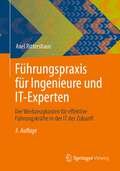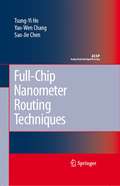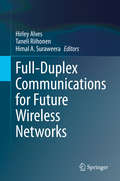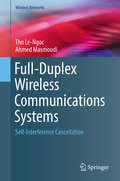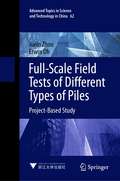- Table View
- List View
Führungskraft Ingenieur
by Heinz Meinholz Gabi FörtschZiel dieses Buches ist die Vermittlung weitreichender Kenntnisse zur Mitarbeiterführung für Ingenieure und Naturwissenschaftler. Mit einer strukturierten Kompetenzanalyse können Sie Ihre persönlichen Stärken und Entwicklungspotenziale identifizieren. Anhand der Unterlagen lassen sich selbstständig wichtige Aspekte zur prozessorientierten Personalführung erarbeiten, reflektieren und weiterentwickeln.
Führungskräfte für ein integriertes Management: Wirtschaftsingenieurwesen in Wissenschaft und Unternehmenspraxis
by Hartmut Zadek Jörg RisseFührungskräfte in der Industrie, im Handel und in Dienstleistungsbetrieben, vor allem Manager an der Nahtstelle von Technik, Wirtschaft und Informationstechnik, müssen den Anforderungen genügen, die heute an ein integriertes und damit auch strategisches Management gestellt werden. Das Buch bereitet die Erfolgsfaktoren und Wirkungsfelder kompakt und anschaulich auf. Es zeigt, welche Bedeutung die Human Resources für das integrierte Management haben und wie man die Führungspersönlichkeiten hierfür gewinnt. Eine wesentliche Rolle spielt dabei das Ausbildungskonzept zum Wirtschaftsingenieur. Der modulare Aufbau des Buches ermöglicht eine zielgenaue Information; er macht komplexes Expertenwissen strukturiert und selektiv abrufbar. Die praxisrelevanten Beispiele aus renommierten und innovativen Unternehmungen bieten zudem einen besonderen Nutzen. Das Buch spricht damit vor allem den Praktiker an.
Führungspraxis für Ingenieure und IT-Experten: Der Werkzeugkasten für effektive Führungskräfte in der IT der Zukunft
by Axel RittershausDas Buch geht auf die konkreten Probleme der Führung in der IT ein, räumt mit überholten Standardlehren auf und konzentriert sich auf die Fähigkeiten der IT-Führungskraft der Zukunft. Der Leser erhält sofort umsetzbare Handlungsempfehlungen, die durch Fallbeispiele auf Basis von Interviews mit IT-Führungskräften internationaler Unternehmen ergänzt werden.Wenn Sie es als IT-Führungskraft satt haben, dass die IT als Kostenfaktor statt als Business Enabler gesehen wird, wenn Sie überzeugt sind, dass die IT der Zukunft eine ganz andere Arbeits- und Führungsweise erfordert, wenn Ihre IT nicht mehr als Handlanger zur sinnbefreiten Kennzahlen-Generierung missbraucht, sondern als innovativer Partner des Business akzeptiert werden soll, dann ist dieses Buch genau das Richtige. Wollen Sie jedoch weitermachen wie bislang, ist es nichts für Sie.
Führungspraxis für Ingenieure und IT-Experten: Der Werkzeugkasten für effektive Führungskräfte in der IT der Zukunft
by Axel RittershausDas Buch geht auf die konkreten Probleme der Führung in der IT ein, räumt mit überholten Standardlehren auf und konzentriert sich auf die Fähigkeiten der IT-Führungskraft der Zukunft. Der Leser erhält sofort umsetzbare Handlungsempfehlungen, die durch Fallbeispiele auf Basis von Interviews mit IT-Führungskräften internationaler Unternehmen ergänzt werden.Wenn Sie es als IT-Führungskraft satt haben, dass die IT als Kostenfaktor statt als Business Enabler gesehen wird, wenn Sie überzeugt sind, dass die IT der Zukunft eine ganz andere Arbeits- und Führungsweise erfordert, wenn Ihre IT nicht mehr als Handlanger zur sinnbefreiten Kennzahlen-Generierung missbraucht, sondern als innovativer Partner des Business akzeptiert werden soll, dann ist dieses Buch genau das Richtige. Wollen Sie jedoch weitermachen wie bislang, ist es nichts für Sie.
Führungspraxis für Ingenieure und IT-Experten: Der Werkzeugkasten für effektive Führungskräfte in der IT der Zukunft
by Axel RittershausDas Buch geht auf die konkreten Probleme der Führung in der IT ein, räumt mit überholten Standardlehren auf und konzentriert sich auf die Fähigkeiten der IT-Führungskraft der Zukunft. Der Leser erhält sofort umsetzbare Handlungsempfehlungen, die durch Fallbeispiele auf Basis von Interviews mit IT-Führungskräften internationaler Unternehmen ergänzt werden.Wenn Sie es als IT-Führungskraft satt haben, dass die IT als Kostenfaktor statt als Business Enabler gesehen wird, wenn Sie überzeugt sind, dass die IT der Zukunft eine ganz andere Arbeits- und Führungsweise erfordert, wenn Ihre IT nicht mehr als Handlanger zur sinnbefreiten Kennzahlen-Generierung missbraucht, sondern als innovativer Partner des Business akzeptiert werden soll, dann ist dieses Buch genau das Richtige. Wollen Sie jedoch weitermachen wie bislang, ist es nichts für Sie.
Führungswissen für Bau- und Immobilienfachleute: Bauwirtschaft, Unternehmensführung, Immobilienmanagement, Privates Baurecht
by Claus J. DiederichsFührungswissen für Bau- und Immobilienfachleute 1: Grundlagen, Betriebswirtschaft, Unternehmensrechnung, Baubetriebsrechnung, Nachträge und Claims, Wirtschaftlichkeit, Unternehmensfinanzierung
by Claus Jürgen DiederichsDas Buch beinhaltet das betriebliche Basiswissen für eine fundierte Unternehmensführung. Das Grundwissen wird ergänzt um Ausführungen zur Wirtschaftspolitik und zum europäischen System der Zentralbanken. Behandelt werden auch die Bilanzansatz- und Bewertungsvorschriften nach International Accounting Standards (IAS) und Basiswissen zur Behandlung von Nachträgen bei Leistungsänderungen und Leistungsstörungen. Die Methoden und Anwendungsbereiche für monetäre Wirtschaftlichkeitsberechnungen und Nutzen-Kosten-Untersuchungen unter Einbeziehung auch nichtmonetärer Faktoren sowie die Darstellung der Anforderungen an die Unternehmensausrichtung für das Unternehmensrating (nach Basel II) und an die Unternehmensfinanzierung zur Insolvenzvermeidung sind bestimmende Faktoren für eine erfolgreiche Unternehmensführung. Aufmerksam werden die Leser auch die neuen Ausführungen über die Auswirkungen von Schwarzarbeit und Korruption lesen. Für wen ist dieses Buch nützlich? Führungskräfte mit dem Hintergrund einer Ingenieur- oder einer Architekturausbildung und einer juristischen oder betriebswirtschaftlichen Grundbildung, aber auch jene, die sich erst mit diesem Buch in die komplexe Materie im Spannungsfeld zwischen Jura, Betriebswirtschaftslehre, Immobilienwirtschaft und dem vielfältigen Planen und Bauen einarbeiten wollen. Viel Wissenswertes, eine konzentrierte Quelle von wesentlichen bauwirtschaftlichen Zusammenhängen und technischen Darstellungen, für ihre Praxisaufgaben.
Fukushima: Impacts and Implications
by D. ElliottThe Fukushima nuclear disaster in March 2011 led Japan, and many other countries, to change their energy policies. David Elliott reviews the disaster and its global implications, asking whether, despite continued backing by some governments, the growing opposition to nuclear power means the end of the global nuclear renaissance.
The Fukushima Daiichi Nuclear Accident: Final Report of the AESJ Investigation Committee
by Atomic Energy Society of JapanThe Magnitude 9 Great East Japan Earthquake on March 11, 2011, followed by a massive tsunami struck TEPCO’s Fukushima Daiichi Nuclear Power Station and triggered an unprecedented core melt/severe accident in Units 1 – 3. The radioactivity release led to the evacuation of local residents, many of whom still have not been able to return to their homes.As a group of nuclear experts, the Atomic Energy Society of Japan established the Investigation Committee on the Nuclear Accident at the Fukushima Daiichi Nuclear Power Station, to investigate and analyze the accident from scientific and technical perspectives for clarifying the underlying and fundamental causes, and to make recommendations. The results of the investigation by the AESJ Investigation Committee has been compiled herewith as the Final Report.Direct contributing factors of the catastrophic nuclear incident at Fukushima Daiichi NPP initiated by an unprecedented massive earthquake/ tsunami – inadequacies in tsunami measures, severe accident management, emergency response, accident recovery and mitigations – and the underlying factors - organizational issues, etc., have been clarified and recommendations in the following areas have been made.- Nuclear safety fundamentals- Direct factors of the accident- Organizational aspects- Common items (R&D, International cooperation, human resources management)- Post-accident management/recovery from the accident.
The Fukushima Daiichi Nuclear Power Station Disaster: Investigating the Myth and Reality
by The Independent Fukushima Nuclear AccidentWhen the Nuclear Safety Commission in Japan reviewed safety-design guidelines for nuclear plants in 1990, the regulatory agency explicitly ruled out the need to consider prolonged AC power loss. In other words, nothing like the catastrophe at the Fukushima Daiichi Nuclear Power Station was possible—no tsunami of 45 feet could swamp a nuclear power station and knock out its emergency systems. No blackout could last for days. No triple meltdown could occur. Nothing like this could ever happen. Until it did—over the course of a week in March 2011. In this volume and in gripping detail, the Independent Investigation Commission on the Fukushima Nuclear Accident, a civilian-led group, presents a thorough and powerful account of what happened within hours and days after this nuclear disaster, the second worst in history. It documents the findings of a working group of more than thirty people, including natural scientists and engineers, social scientists and researchers, business people, lawyers, and journalists, who researched this crisis involving multiple simultaneous dangers. They conducted over 300 investigative interviews to collect testimony from relevant individuals. The responsibility of this committee was to act as an external ombudsman, summarizing its conclusions in the form of an original report, published in Japanese in February 2012. This has now been substantially rewritten and revised for this English-language edition. The work reveals the truth behind the tragic saga of the multiple catastrophic accidents at the Fukushima Daiichi Nuclear Power Station.It serves as a valuable and essential historical reference, which will help to inform and guide future nuclear safety and policy in both Japan and internationally.
The Fukushima Daiichi Nuclear Power Station Disaster: Investigating the Myth and Reality
by The Independent Fukushima Nuclear AccidentWhen the Nuclear Safety Commission in Japan reviewed safety-design guidelines for nuclear plants in 1990, the regulatory agency explicitly ruled out the need to consider prolonged AC power loss. In other words, nothing like the catastrophe at the Fukushima Daiichi Nuclear Power Station was possible—no tsunami of 45 feet could swamp a nuclear power station and knock out its emergency systems. No blackout could last for days. No triple meltdown could occur. Nothing like this could ever happen. Until it did—over the course of a week in March 2011. In this volume and in gripping detail, the Independent Investigation Commission on the Fukushima Nuclear Accident, a civilian-led group, presents a thorough and powerful account of what happened within hours and days after this nuclear disaster, the second worst in history. It documents the findings of a working group of more than thirty people, including natural scientists and engineers, social scientists and researchers, business people, lawyers, and journalists, who researched this crisis involving multiple simultaneous dangers. They conducted over 300 investigative interviews to collect testimony from relevant individuals. The responsibility of this committee was to act as an external ombudsman, summarizing its conclusions in the form of an original report, published in Japanese in February 2012. This has now been substantially rewritten and revised for this English-language edition. The work reveals the truth behind the tragic saga of the multiple catastrophic accidents at the Fukushima Daiichi Nuclear Power Station.It serves as a valuable and essential historical reference, which will help to inform and guide future nuclear safety and policy in both Japan and internationally.
Full-Chip Nanometer Routing Techniques (Analog Circuits and Signal Processing)
by Tsung-Yi Ho Yao-Wen Chang Sao-Jie ChenThis book presents a novel multilevel full-chip router, namely mSIGMA for SIGnal-integrity and MAnufacturability optimization. These routing technologies will ensure faster time-to-market and time-to-profitability. The book includes a detailed description on the modern VLSI routing problems, and multilevel optimization on routing design to solve the chip complexity problem.
The Full Costs and Benefits of Transportation: Contributions to Theory, Method and Measurement
by David L. Greene Donald W. Jones Mark A. DelucchiModern transportation systems have far-reaching, and serious consequences: deaths and injuries from accidents, pollution of air, water and groundwater, noise congestion, and the greenhouse effect. As world transport systems expand and become increasingly motorised, the transportation community is searching for systems that are both efficient and sustainable. Here, leading international researchers explore the issues and concepts and define the state of knowledge concerning the full costs and benefits of transportation.
Full-Duplex Communications for Future Wireless Networks
by Hirley Alves Taneli Riihonen Himal A. SuraweeraThis book focuses on the multidisciplinary state-of-the-art of full-duplex wireless communications and applications. Moreover, this book contributes with an overview of the fundamentals of full-duplex communications, and introduces the most recent advances in self-interference cancellation from antenna design to digital domain. Moreover, the reader will discover analytical and empirical models to deal with residual self-interference and to assess its effects in various scenarios and applications. Therefore, this is a highly informative and carefully presented book by the leading scientists in the area, providing a comprehensive overview of full-duplex technology from the perspective of various researchers, and research groups worldwide. This book is designed for researchers and professionals working in wireless communications and engineers willing to understand the challenges and solutions full-duplex communication so to implement a full-duplex system.
Full-Duplex Wireless Communications Systems: Self-Interference Cancellation (Wireless Networks)
by Tho Le-Ngoc Ahmed MasmoudiThis book introduces the development of self-interference (SI)-cancellation techniques for full-duplex wireless communication systems. The authors rely on estimation theory and signal processing to develop SI-cancellation algorithms by generating an estimate of the received SI and subtracting it from the received signal. The authors also cover two new SI-cancellation methods using the new concept of active signal injection (ASI) for full-duplex MIMO-OFDM systems. The ASI approach adds an appropriate cancelling signal to each transmitted signal such that the combined signals from transmit antennas attenuate the SI at the receive antennas. The authors illustrate that the SI-pre-cancelling signal does not affect the data-bearing signal. This book is for researchers and professionals working in wireless communications and engineers willing to understand the challenges of deploying full-duplex and practical solutions to implement a full-duplex system. Advanced-level students in electrical engineering and computer science studying wireless communications will also find this book useful as a secondary textbook.
Full Field Inversion Methods in Ocean and Seismo-Acoustics (Modern Approaches in Geophysics #12)
by Orest Diachok Andrea Caiti Peter Gerstoft Henrik SchmidtRecent advances in the power of inversion methods, the accuracy of acoustic field prediction codes, and the speed of digital computers have made the full field inversion of ocean and seismic parameters on a large scale a practical possibility. These methods exploit amplitude and phase information detected on hydrophone/geophone arrays, thereby extending traditional inversion schemes based on time of flight measurements. Full field inversion methods provide environmental information by minimising the mismatch between measured and predicted acoustic fields through a global search of possible environmental parameters. Full Field Inversion Methods in Ocean and Seismo-Acoustics is the formal record of a conference held in Italy in June 1994, sponsored by NATO SACLANT Undersea Research Centre. It includes papers by NATO specialists and others. Topics covered include: · speed and accuracy of acoustic field prediction codes · signal processing strategies · global inversion algorithms · search spaces of environmental parameters · environmental stochastic limitations · special purpose computer architectures · measurement geometries · source and receiving sensor technologies.
Full-Scale Field Tests of Different Types of Piles: Project-Based Study (Advanced Topics in Science and Technology in China #62)
by Jialin Zhou Erwin OhThis book provides full-scale field tests of different types of pile foundations. For the testing, it includes static load tests which consider various loading orientations, dynamic load tests, inclinometer monitoring and tests that aim to determine the load transfer mechanism of pile foundation. This book also covers the up-to-date popular topic with detailed project studies. This includes the academic investigation of post-grouting technology effect on drilled shaft piles, the research of displacement and non-displacement precast pile foundation, the study of fiber-reinforced polymer material used in the geo-technical environment such as deep excavation pit in tunneling project, and the research of super-long and large diameter pile foundations. These investigations provide essential and academic information for researchers as well as engineers in role of Civil and Geotech. Not only the different types of the piles are studied, but also the relevant theory and literatures are reviewed. In this book, the diagrams are plotted in an easy way and the explanation of the diagrams and tables are described in detail. The research methods corresponding to the practical projects are detailed as well. Hence, it is useful as a reference for the students and researchers in civil and geotechnical engineering.
Full Scale Plant Optimization in Chemical Engineering: A Practical Guide
by Zivorad R. LazicHelp protect your network with this important reference work on cyber security Chemical engineers are a vital part of the creation of any process development—lab-scale and pilot-scale—for any plant. In fact, they are the lynchpin of later efforts to scale-up and full-scale plant process improvement. As these engineers approach a new project, there are three generally recognized methodologies that are applicable in industry generally: Design of Experiments (DOE), Evolutionary Operations (EVOP), and Data Mining Using Neural Networks (DM). In Full Scale Plant Optimization in Chemical Engineering, experienced chemical engineer Zivorad R. Lazic offers an in-depth analysis and comparison of these three methods in full-scale plant optimization applications. The book is designed to provide the basic principles and necessary information for complete understanding of these three methods (DOE, EVOP, and DM). The application of each model is further described. Full Scale Plant Optimization readers will also find: A thorough discussion of the advantages, disadvantages, and applications of the different simulation methods for process and plant optimization An overview of the tools that responsible operators and engineers utilize in deciding between different simulation models Particular attention is given to the simple but powerful technique Evolutionary Optimization or EVOP, which provides the experimental tools for the ideal full scale plant optimizationFull Scale Plant Optimization is a useful reference for all chemists in industry, chemical engineers, pharmaceutical chemists, and process engineers.
Full Scale Plant Optimization in Chemical Engineering: A Practical Guide
by Zivorad R. LazicHelp protect your network with this important reference work on cyber security Chemical engineers are a vital part of the creation of any process development—lab-scale and pilot-scale—for any plant. In fact, they are the lynchpin of later efforts to scale-up and full-scale plant process improvement. As these engineers approach a new project, there are three generally recognized methodologies that are applicable in industry generally: Design of Experiments (DOE), Evolutionary Operations (EVOP), and Data Mining Using Neural Networks (DM). In Full Scale Plant Optimization in Chemical Engineering, experienced chemical engineer Zivorad R. Lazic offers an in-depth analysis and comparison of these three methods in full-scale plant optimization applications. The book is designed to provide the basic principles and necessary information for complete understanding of these three methods (DOE, EVOP, and DM). The application of each model is further described. Full Scale Plant Optimization readers will also find: A thorough discussion of the advantages, disadvantages, and applications of the different simulation methods for process and plant optimization An overview of the tools that responsible operators and engineers utilize in deciding between different simulation models Particular attention is given to the simple but powerful technique Evolutionary Optimization or EVOP, which provides the experimental tools for the ideal full scale plant optimizationFull Scale Plant Optimization is a useful reference for all chemists in industry, chemical engineers, pharmaceutical chemists, and process engineers.
Full-Stack Vue.js 2 and Laravel 5: Bring The Frontend And Backend Together With Vue, Vuex, And Laravel
by Anthony GoreVue is a JavaScript framework that can be used for anything from simple data display to sophisticated front-end applications and Laravel is a PHP framework used for developing fast and secure web-sites. This book gives you practical knowledge of building modern full-stack web apps from scratch using Vue with a Laravel back end. In this book, you will build a room-booking website named "Vuebnb". This project will show you the core features of Vue, Laravel and other state-of-the-art web development tools and techniques. The book begins with a thorough introduction to Vue.js and its core concepts like data binding, directives and computed properties, with each concept being explained first, then put into practice in the case-study project. You will then use Laravel to set up a web service and integrate the front end into a full-stack app. You will be shown a best-practice development workflow using tools like Webpack and Laravel Mix. With the basics covered, you will learn how sophisticated UI features can be added using ES+ syntax and a component-based architecture. You will use Vue Router to make the app multi-page and Vuex to manage application state. Finally, you will learn how to use Laravel Passport for authenticated AJAX requests between Vue and the API, completing the full-stack architecture. Vuebnb will then be prepared for production and deployed to a free Heroku cloud server.
Fullerene Nanowhiskers
by Kun’ichi Miyazawa, Yuichi Ochiai, Masaru Tachibana, Tokushi Kizuka and Shigeo NakamuraFullerenes became a new member of carbon allotropes in addition to diamond and graphite after the discovery of C60 (carbon 60) by Kroto et al. in 1985. The model of C60 was first proposed by Osawa in 1970. C60 is a hollow spherical molecule composed of 60 carbon atoms that contains 12 five-membered rings and 20 six-membered rings and has the same structure as a soccer ball. In 2001, C60 fullerene nanowhiskers (FNWs), which are single-crystal nanowhiskers solely composed of C60 molecules, were discovered in a colloidal solution of lead zirconate titanate (PZT) with added C60. This book focuses on the synthesis of FNWs, fullerene nanotubes, and fullerene nanosheets and describes the structural, mechanical, semiconducting, and thermal properties, as well as bio-related and solar applications of FNWs and related fullerene nanomaterials.
Fullerene Nanowhiskers
by Kun'Ichi Miyazawa Yuichi Ochiai Masaru Tachibana Tokushi Kizuka Shigeo NakamuraFullerenes became a new member of carbon allotropes in addition to diamond and graphite after the discovery of C60 (carbon 60) by Kroto et al. in 1985. The model of C60 was first proposed by Osawa in 1970. C60 is a hollow spherical molecule composed of 60 carbon atoms that contains 12 five-membered rings and 20 six-membered rings and has the same structure as a soccer ball. In 2001, C60 fullerene nanowhiskers (FNWs), which are single-crystal nanowhiskers solely composed of C60 molecules, were discovered in a colloidal solution of lead zirconate titanate (PZT) with added C60. This book focuses on the synthesis of FNWs, fullerene nanotubes, and fullerene nanosheets and describes the structural, mechanical, semiconducting, and thermal properties, as well as bio-related and solar applications of FNWs and related fullerene nanomaterials.
Fullerene Polymers and Fullerene Polymer Composites (Springer Series in Materials Science #38)
by Peter C. Eklund Apparao M. RaoThis in-depth experimental and theoretical account explores polymers and composites whose unusual properties (such as photophysical phenomena, electrical transport, phase transitions, and magnetic properties) stem from the incorporation of C60 in the material. Introductory chapters on the fundamental properties of fullerenes (C60, C70) and photophysical phenomena in fullerenes and polymers are also included.
Fullerenes and Related Structures (Topics in Current Chemistry #199)
by Andreas HirschThe aesthetically pleasing molecular architectures of fullerenes and nanotubes are appealing not only because of their beauty but also because they are responsible for the many unprecedented chemical and physical properties of this compound class. Although succession of exciting new discoveries continues unabated fullerene research has become a mature science. It is now possible to predict fullerene chemistry, to design new structure variations like open fullerene clusters, heterofullerenes and endohedral fullerenes, and to develop fullerene materials and modified nanotubes with high potential for technological applications. This volume represents the state-of-the-art of fullerene research, focussing on areas showing high potential for future growth and practical applications. The authors are leading scientists whose groups are making major contributions in the field.




